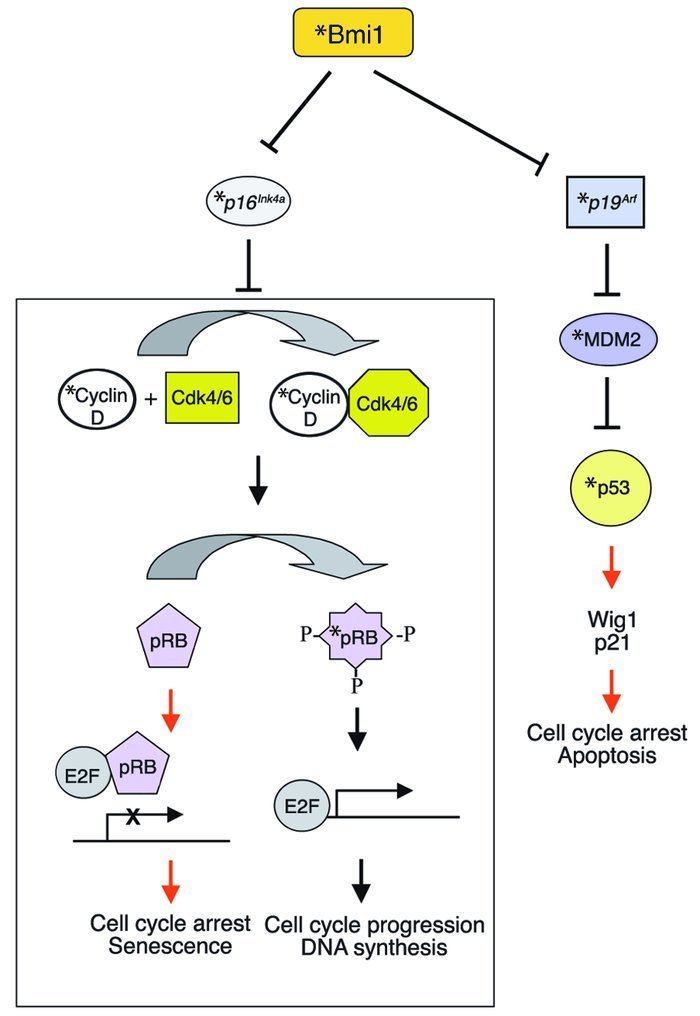Entrez 648 | Ensembl ENSG00000168283 | |
 | ||
External IDs HomoloGene: 136787 GeneCards: BMI1 | ||
Polycomb complex protein BMI-1 also known as polycomb group RING finger protein 4 (PCGF4) or RING finger protein 51 (RNF51) is a protein that in humans is encoded by the BMI1 gene (B cell-specific Moloney murine leukemia virus integration site 1). BMI1 is a polycomb ring finger oncogene.
Contents
Unikl bmi1 nric2009
Function
BMI1 (B lymphoma Mo-MLV insertion region 1 homolog) has been reported as an oncogene by regulating p16 and p19, which are cell cycle inhibitor genes. Bmi1 knockout in mice results in defects in hematopoiesis, skeletal patterning, neurological functions, and development of the cerebellum. Recently it has been reported BMI1 is rapidly recruited to sites of DNA damage and it sustains for over than 8h. Loss of BMI1 leads to radiation sensitive and impaired repair of DNA double-strand breaks by homologous recombination 10.
Bmi1 is necessary for efficient self-renewing cell divisions of adult hematopoietic stem cells as well as adult peripheral and central nervous system neural stem cells. However, it is less important for the generation of differentiated progeny. Given that phenotypic changes in Bmi1 knockout mice are numerous and that Bmi1 has very broad tissue distribution, it is possible that it regulates the self-renewal of other types of somatic stem cells.
Bmi1 is also thought to inhibit ageing in neurons through the suppression of p53.
The Bmi-1 expression interacts with several signaling containing Wnt, Akt, Notch, Hedgehog and receptor tyrosine kinase (RTK) pathway. In Ewing sarcoma family of tumors (ESFT), the knockdown of BMI-1 gene would greatly influence the Notch and Wnt signaling pathway which are important for ESFT formation and development. Bmi-1 was shown to mediate the effect of Hedgehog signaling pathway on mammary stem cell proliferation. Bmi-1 also regulates multiple downstream factors or genes. It represses p19Arf and p16Ink4a. Bmi-1-/- neural stem cells and HSCs have high expression level of p19Arf and p16Ink4a which diminished the proliferation rate. Bmi-1 is also indicated as a key factor in controlling Th2 cell differentiation and development by stabilizing GATA transcription factors.
Structure
The BMI-1 gene is 10.04 kb with 10 exon and is highly conserved sequence between species. The human BMI-1 gene localizes at chromosome 10 (10p11.23). The Bmi-1 protein is consist of 326 amino acids and has a molecular weight of 36949 Da. Bmi1 has a RING finger at the N-terminus and a central helix-turn-helix domain. The ring finger domain is a cysteine rich domain (CRD) involved in zinc binding and contributes to the ubiquitination process. The binding of bmi-1 to Ring 1B would activate the E3 ubiquitin ligase activity greatly. It is indicated that both the RING domain and the extended N-terminal tail contribute to the interaction of bmi-1 and Ring 1B.
Clinical significance
Overexpression of Bmi1 seems to play an important role in several types of cancer, such as bladder, skin, prostate, breast, ovarian, colorectal as well as hematological malignancies. Its amplification and overexpression is especially pronounced in mantle cell lymphomas. Inhibiting BMI1 has been shown to inhibit the proliferation of glioblastoma multiforme, chemoresistant ovarian cancer, prostatic, pancreatic and skin cancers. Colorectal cancer stem cell self-renewal was reduced by BMI1 inhibition. The colon cancer stem cells in mouse xenografts could be eliminated by inhibiting BMI-1 gene, providing a novel potential method to cure colorectal cancer.
Interactions
BMI1 has been shown to interact with:
